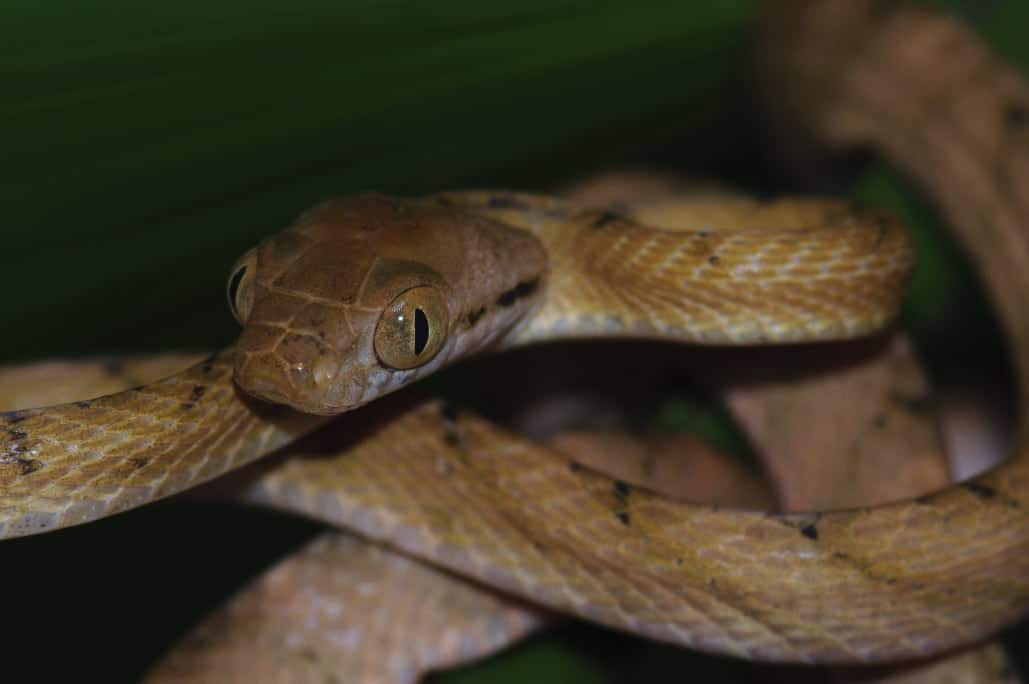In addition to effectively changing that island’s ecology, the snake has caused power failures and efforts to eradicate it have cost millions of dollars.
The brown tree snake is an an incredibly invasive species on Guam, having decimated the native bird populations and causing millions in damage to the island nation. In an effort to prevent Boiga irregularis from establishing in Hawai‘i, the U.S. Department of Interior has approved $375,000 in federal funding to the state’s Hawai’i Department of Agriculture to use to bolster its defenses in preventing the snake from getting into the state.
The money is part of $3.66 million approved by the department to combat the invasive species in the Pacific Islands. The money will be used in inspection and interdiction activities as well as the state’s Detector Dog Program that is used to insect incoming air and sea flights and cargo shipments from Guam, Northern and Eastern Coastal Australia, Eastern Indonesia, Papua New Guinea and the Solomon Island, all locations where the brown tree snake is either native or invasive. The monies also will go toward snake traps around military and commercial airports on Oahu and staff training in detection capture and handling of the brown tree snake. Monies will also go toward increasing the number of traps in and around Hickam Air Force base as well as potentially deploying traps around Marine Corps Base Hawai‘i in Kāne‘ohe and at Kalaeloa Airport, the press release announcing the monies noted.
“The federal funding for brown tree snake prevention efforts has been crucial to keeping the greatest invasive threat out of Hawai‘i,” HDOA Chairperson Sharon Hurd said in statement released by Gov. Josh Green’s office. “While other invasive species get the headlines, the general public does not realize how much work the department does to keep BTS out of Hawai‘i or the amount of training our staff undergo to be able to respond rapidly to reports of snakes in Hawai‘i. We are also grateful for our federal partners on Guam who have been extremely diligent in helping to keep BTS from reaching Hawai‘i.”
Invasive Brown Tree Snake On Guam Leads To Explosion In Spider Populations
Eight brown tree snakes have been found on O’ahu since 1981, with the last specimen found dead in a wheel well of a commercial airplane in 1998. According to the press release, about 3,000 brown tree snakes are captured along the perimeter fence of Anderson Air Force Base on Guam every year.
Brown Tree Snake Information
The brown tree snake has caused all sorts of problems on Guam. In addition to effectively changing that island’s ecology, the snake has caused power failures and efforts to eradicate it have cost millions of dollars. The snake is responsible for the extinction of nine native forest birds on Guam and three lizard species. Other bird species on the island have been significantly impacted by this snake and certain sea bird species no longer nest there. With these birds removed from the ecosystem, the island’s spider populations have gone largely unchecked, according to a study published in the journal PLoS One.
Prior to the introduction of the brown tree snake on Guam, there were 10 native birds that were known to eat insects: Bridled White-eye (Zosterops conspicillatus), Rufous Fantail (Rhipidura rufifrons), Micronesian Starling (Aplonis opaca), Mariana Swiftlet (Aerodramus bartschi), Cardinal Honeyeater (Myzomela rubratra), Nightingale Reed-Warbler (Acrocephalus luscinia), Mariana Crow (Corvus kubaryi), Micronesian Kingfisher (Todiramphus cinnamominus), Guam Flycatcher (Myiagra freycineti), and the Guam Rail (Gallirallus owstoni).
The snake is a nocturnal, rear fanged venomous species of the family Colubridae. It is native to northern Australia, New Guinea, and the Solomon Islands. It averages two to four feet in length, with the largest specimen captured on Guam measuring 10 feet. It feeds on lizards, rats, birds, shrews, and other small animals.



